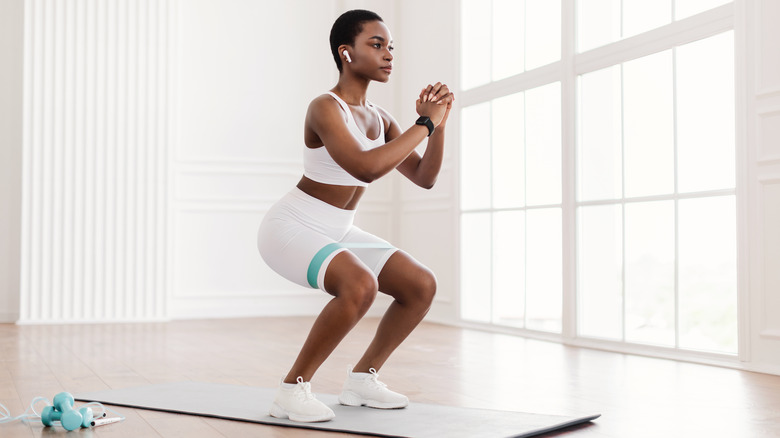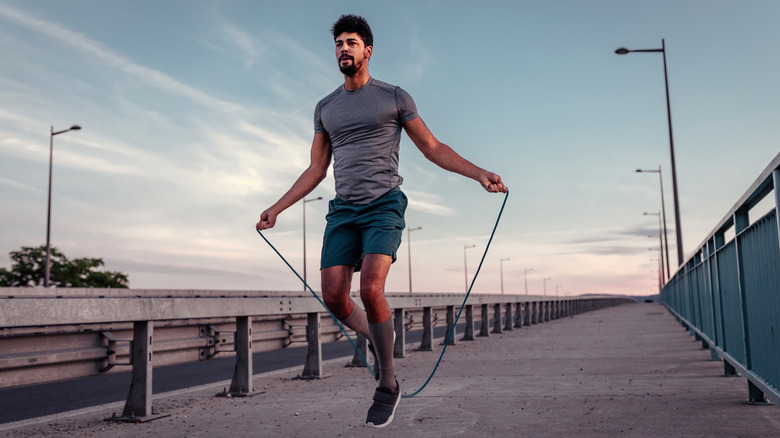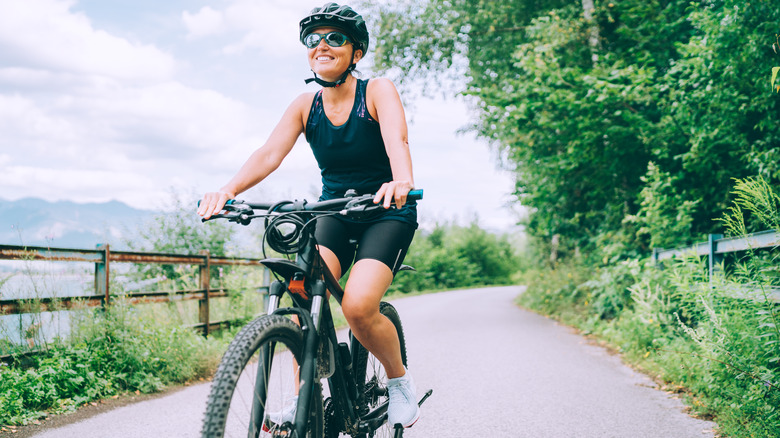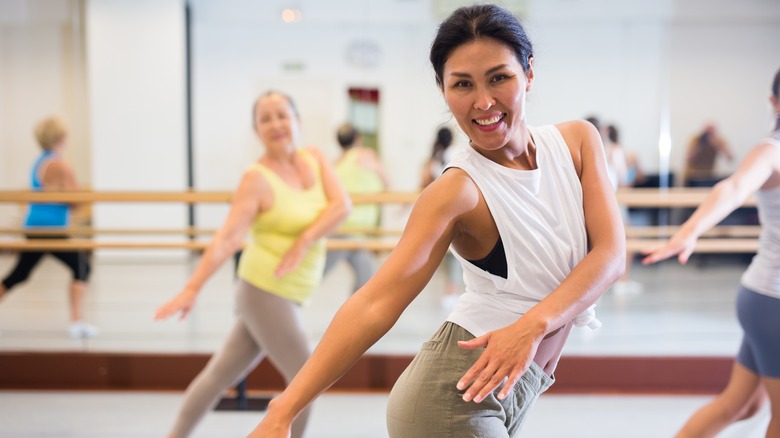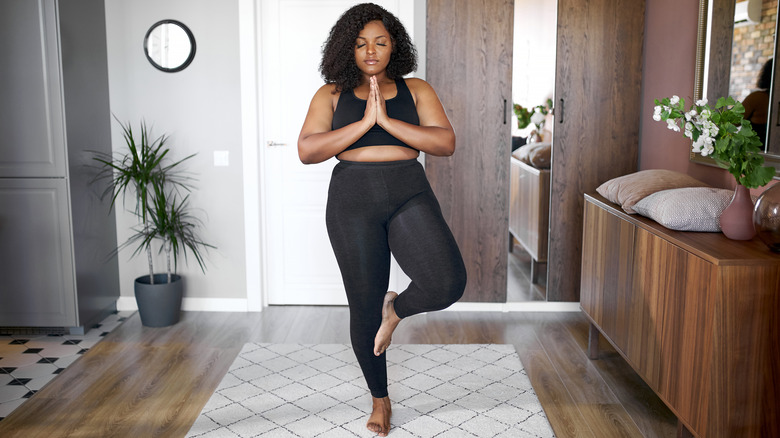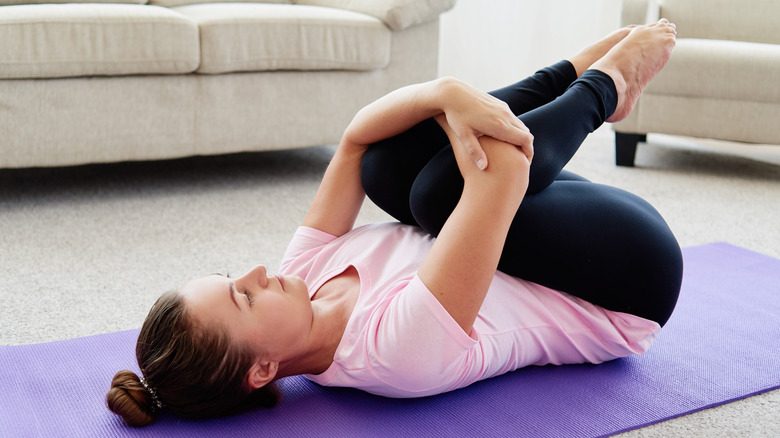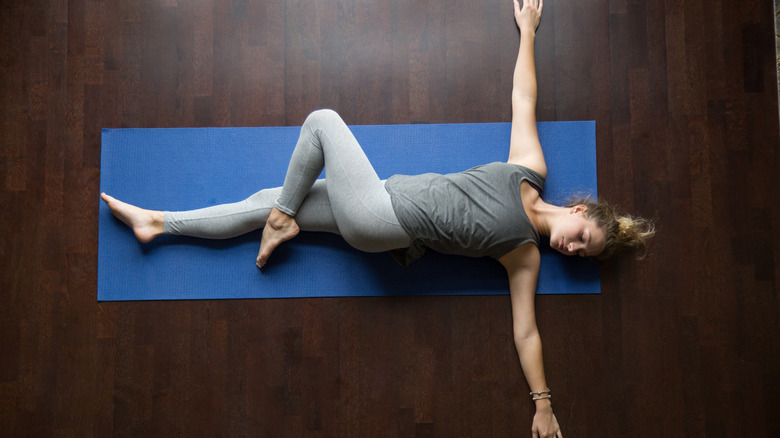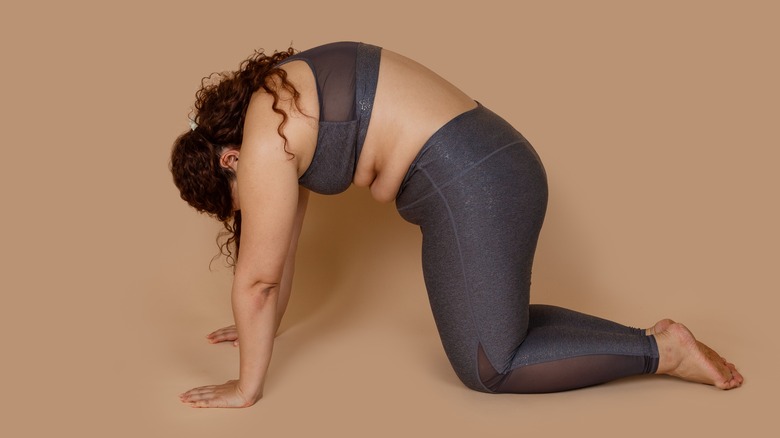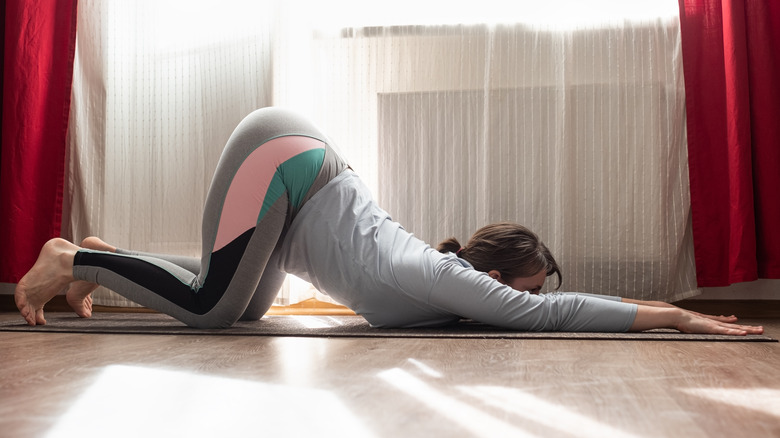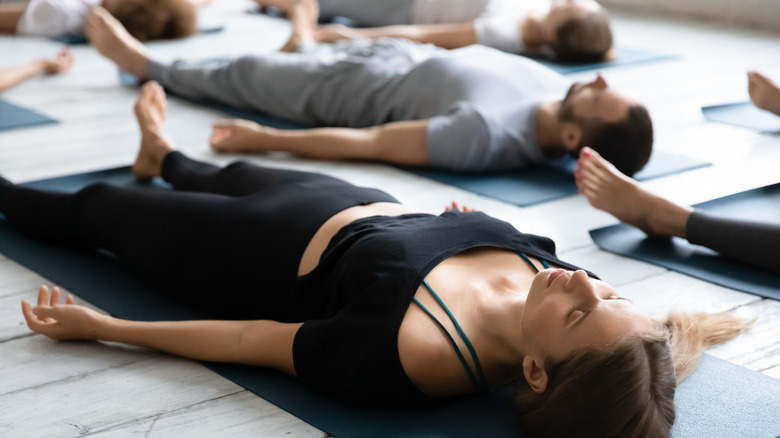Exercises To Help Ease Your Crohn's Disease Symptoms
If you've been diagnosed with Crohn's disease, it may feel like your world is crashing down around you. Crohn's is classified as a type of chronic inflammatory bowel disease (IBD) that causes irritation and inflammation in the digestive tract (via the Cleveland Clinic). It leads to symptoms like abdominal pain, diarrhea, feeling full often, weight loss, rectal bleeding, and many other digestive issues. While the exact cause is unknown, there are certain factors that are thought to increase your risk, like genetics, smoking, and having an autoimmune condition. If you suspect you might have Crohn's, visit your doctor so that they can order tests to help you find solutions to your symptoms. Receiving a diagnosis and treatment are important steps to help avoid health complications that can occur from Crohn's, like malnutrition or colon cancer.
Even though there is no cure for Crohn's, there are many different lifestyle habits and treatment options you can explore to help prevent flares. Some helpful tips for symptom management include maintaining a healthy diet, keeping stress levels down, and consistent exercise.
How exercise can help
Regular exercise is a big part of maintaining a healthy lifestyle, and people struggling with Crohn's may find some particular exercises can help mitigate symptoms. While a workout regime alone may not send you into remission, exercise can help support your digestive system and boost your overall health, which in turn can increase your mood and energy, boost your immune system, and reduce your symptoms (via Healthline). Many health professionals think that exercise helps with Crohn's symptoms by reducing stress levels. And a research study published in Inflammatory Bowel Diseases found that for those in remission, engaging in high levels of exercise did help reduce the chances of flare-ups.
Of course, when you're experiencing symptoms, exercise may be the last thing on your mind. You may feel too tired or find that exercise it too uncomfortable. Listen to your body and don't push it — sometimes rest is what your body needs (via Crohn's & Colitis Foundation). During flares, rest and limiting exercise is generally recommended. You may find that light movement is helpful. Everyone's condition is different, so speak with your doctor to find options that work best for you, both during a flare and while in remission.
Walking
Many types of workouts can cause your body to release endorphins — the "feel-good" hormones (via Crohn's & Colitis Foundation). This is a big reason exercise is recommended for those with Crohn's, as it helps boost mental health and reduce feelings of anxiety and depression that can be exacerbated by the disease. However, people with Crohn's may find that high-impact exercise is too exhausting, leaving them feeling depleted instead of energized (via Healthline). This is why many doctors suggest low-impact and light types of exercise to patients, such as walking for 30 minutes several times per week. In fact, one scientific study found that when people with Crohn's walked an average of 30 minutes at least three times per week, their symptoms improved and their chances of experiencing a flare were drastically reduced (per The American Journal of Gastroenterology). The participants in the study also reported experiencing psychological improvements along with their physical health benefits.
Strength and resistance training
Strength training has many benefits, like helping to maintain healthy weight, supporting your ability to do everyday tasks, keeping your mind sharp, and helping manage symptoms from chronic conditions like depression and heart disease (via Mayo Clinic). Plus, strength training can help boost your bone density and decrease your chances of developing osteoporosis, which is common in people with Crohn's disease. Unfortunately, those who struggle with Crohn's have a hard time absorbing vitamin D, which can lead to bone weakness over time (via Everyday Health). An average of 30-60% of patients with an IBD experience below-average bone density.
Resistance training is a type of strength training that involves pushing or pulling against force, which can also help build muscles and strengthen bone density (via Medical News Today). Strength training and resistance training are similar but slightly different — the main difference is that strength training generally involves building muscles by using weight, while resistance training typically utilizes bodyweight, elastic bands or other tools that create a resistance to build strength (via Stylist). According to one meta-analysis, the two best types of workouts for those with Crohn's are aerobic activity and resistance training. You don't need a gym membership to practice resistance training — there are many different types, some of which can be done at home. Some common resistance training exercises include crunches, back extensions, push-ups, squats, and lunges (via Healthline).
Impact exercises
A recent study published by Alimentary Pharmacology and Therapeutics found that when adults with Crohn's disease incorporated both impact and resistance training in a workout regime, their risk of osteoporotic fractures and other bone issues decreased. The impact exercises that the participants in the study practiced included jumping rope for up to five minutes and different types of multidimensional jump exercises, like squat jumps, broad jumps, and scissor jumps.
Jumping rope is actually considered a low-impact workout, but it can burn more calories than swimming and utilizes more muscles in your body (via Men's Health). Not only that, but it's time efficient: one study showed that just jumping rope for 10 minutes gives your cardiovascular system the same type of workout as 30 minutes of jogging. Jumping rope can help you tone both your upper and lower body, and even your core muscles, depending on the style of jumping you do. Plus, getting started is pretty simple: All you need is a rope and enough space to jump in.
Cycling
Cycling is a type of aerobic activity that can help you build muscle and bone density, support joint mobility, and reduce stress, anxiety, and depression (via Better Health Channel). In a study published in the BMC Gastroenterology, participants with Crohn's reported that cycling was a beneficial form of exercise for them, with some sharing they liked it because it could be controlled and modified depending on their fitness level. The study found that cycling, either as a part of high-intensity interval training or moderate-intensity continuous training, did not cause a Crohn's flare-up in both those in remission and experiencing mild symptoms.
If you don't own a bicycle, no problem — many U.S. cities now have programs where you can rent a bicycle and take it for a spin (via National Association of City Transportation Officials). Buying a stationary bike to have at home or using one at the gym are other options. If you have health complications that makes cycling feel inaccessible to you, you may want to give hand cycling a try (per Move United).
Dancing
If you find workouts like walking or cycling to be boring, why not give dancing a try? Dancing isn't usually the first exercise that comes to mind when you think of working out, however, it can be a fun and effective way to work up a sweat (via Time). Dancing can also increase the amount of endorphins released in the brain, which can help uplift your mood and reduce feelings of depression (via Everyday Health). Dancing is a full-body workout that requires a lot of energy and burns a lot of calories (130-150 an hour, per WebMD, about the same as jogging) due to it's high movement demands — it basically requires moving in almost every direction, oftentimes quickly (via Time). While running and cycling are rhythmic and get fueled by momentum, dancing is sporadic, keeping your brain and body guessing and working hard. Plus, you can choose your intensity level depending on your favorite dance style, ranging from slower dances like the tango to fast-moving dances like salsa or hip hop.
Swimming
Swimming is another type of low-impact exercise that can be helpful for people with Crohn's disease. Studies have shown that swimming can increase bone strength and density (via Everyday Health). It can also help lower your blood pressure, boost your mood, and strengthen your immune system. Swimming has also been shown to soothe arthritis pain, which is one of the most common issues associated with Crohn's outside of the digestive system — one in every four people with Crohn's also has arthritis. While some people rely on nonsteroidal anti-inflammatory drugs (NSAIDs) for arthritis, many people with Crohn's find that these drugs cause more harm than good, increasing inflammation and irritation in the digestive system.
But what if it's winter? See if you have a gym or community center nearby that has a heated swimming pool you can jump into. And if you don't feel up to swimming, that's totally okay — simply being in the water can be beneficial. According to fitness professional Joan Pagano speaking to Everyday Health, "Just submerging in the warm water is therapeutic to the joints, and can relieve pain."
Yoga
Yoga is a popular form of exercise that has many health benefits. A yoga practice builds mindfulness by promoting slow and intentional movements with controlled breathing (via Healthline). It can help you build muscle strength, become more flexible, and improve your balance while also burning calories. There are many different types of yoga, some of which are more physically demanding than others (via Women's Health Magazine). Since fatigue is a common, life-altering symptom of Crohn's (via the Mayo Clinic), gentle styles of yoga like yin and restorative yoga may feel more accessible to someone experiencing a flare.
Further, research has shown yoga to be beneficial for those with an IBD. One scientific study published in PLoS One found that yoga not only helped IBD patients with stress relief, but participants also reported some symptom relief and improvement in their overall well-being. Another study from the International Journal of Yoga Therapy reported that participants in an 8-week yoga program noticed a reduction in their IBD symptoms. These findings suggest that through promoting stress relief and positive thinking, yoga can contribute to fewer flare-ups (via Everyday Health).
Knees to chest pose
Knees to chest pose is a gentle yoga shape that promotes relaxation and provides a light massage to the large intestine (via Healthline). This pose is also commonly called "wind relieving pose" — for a reason, as it can help get things moving through and eventually out of your digestive tract (via Yoga Basics). To practice this pose, begin lying down on your back with your legs straight, either on your yoga mat or a comfortable place. Then slowly bend your knees, pulling them up toward your chest. Grab ahold of your knees or the front of your shins to pull your legs in more and deepen the stretch. Try to stay in this shape for four to five deep breaths.
Alternatively, you can try the half gas release pose, which involves just hugging one knee to your chest at a time (via Yoga Journal). This method puts pressure on the ascending colon on the right side, then the descending colon on the left, which can help to activate the nerves in your torso and support elimination. Start by hugging your right knee in toward the right side of your ribcage while you keep your left leg straight on the ground. Stay here for one to two minutes, breathing deeply, then repeat that shape on the left side.
Supine spinal twist
According to David T. Rubin, the lead scientific adviser for GI Research Foundation, positions that involve side stretches and twists can help support digestive health (via Everyday Health). One such pose is the supine twist, which is believed to help reduce bloating and relieve digestive upset (via Healthline). To practice this posture, begin lying down on your back on a mat or comfortable surface. Bend both of your knees and place the soles of your feet on the ground. Move your hips slightly to the right. Then straighten your left knee and rest your left leg on the ground. Hug your right knee in toward your chest, then gently move your right knee over your torso and to the left side. Try to keep your left leg straight and allow your right leg to softly hang over your left leg, without forcing it to the ground. You can place both arms on the ground perpendicular to your body, or use your left hand to press your right knee down toward the ground for a deeper stretch. Try to hold this shape for four to five deep breaths, then gently release. Repeat the same stretch on the other side.
Cat-cow
Cat-cow is a traditional yoga movement that involves flowing through two different yoga poses: cat and cow. This flow helps stretch and massage your stomach muscles, which can increase circulation and improve digestion (via Healthline). To practice cat-cow, begin on your hands and knees in tabletop position. Be sure that your wrists are underneath your shoulders, your knees are under your hips, the tops of your feet are on the ground, and you have a neutral spine — your back is flat and you're gazing down toward the ground in between your hands. To move into cow pose, look up, activate your core muscles, and move your bellybutton toward the ground, making a U shape with your spine. Hold this shape for several deep breaths. Then move into cat pose by tucking your chin into your chest, rounding your spine, curving your back up toward the sky, and tucking your tailbone. Pause here for four to five deep breaths, then release back to a neutral spine. Repeat this movement a few times.
Extended puppy pose
Not only does puppy pose promote stress relief, but it also helps provide a gentle stretch to the belly. This posture can be especially helpful in easing stomach cramps (via Yoga Journal). To practice this pose, begin on your hands and knees, with your hands underneath your shoulders and your knees under your hips. Then, holding your hips stable, start to shift your hands forward, reaching your fingertips away from your body until you can't go any further. Eventually you will rest your forehead on the ground, or on a yoga block if you have one (via Yoga Journal). Allow gravity to pull your chest toward the ground and try to relax the muscles in the back of your neck. Try to hold this shape anywhere between 30 seconds to a minute, breathing deeply, focusing on extending your spine long and relaxing all of the muscles in your upper body.
Savasana
While you may be tempted to skip savasana, especially if you're doing yoga at home, you won't want to miss this one. This is traditionally the last pose of every yoga class, and it promotes relaxation and stress relief through breathing techniques and meditation (via Healthline). Savasana can help reduce stress, which can often be a trigger of Crohn's and other IBD symptoms (via Yoga Journal). To try out savasana, start by lying down on your back on your yoga mat, with your legs straight and your arms by your sides. Gently close your eyes and start to deepen your breath, noticing your stomach expand with every inhale and contract with every exhale. If you'd like to incorporate a breathing technique, you can try inhaling to the count of four, holding it for a count of four, then exhaling for a count of four (per Healthline). Focus on relaxing all of the muscles in your body, starting at the tips of your toes and moving all the way up to the top of your head. Try to stay in this shape for at least five minutes or longer.
Tips for exercising with Crohn's
Everyone is different and has different needs, so it's important to talk with your doctor about your specific situation to find which type of exercise would be best for you. For those with Crohn's, Healthgrades recommends taking it slow. Don't feel like you need to jump into something new full-force. Start with small goals and listen to your body. If you seem to tolerate a certain activity, then maybe you can increase the intensity level or length of your workout. Also, remember to drink lots of water — hydration is key to any exercise routine, but that's even more true for those struggling with Crohn's, since they are already susceptible to diarrhea and fatigue. You'll also want to make sure you eat two hours or more before exercising to give your body time to digest your food and minimize the chances of any digestive upset occurring during the workout. Lastly, go easy on yourself — every day is different. Just take it one day at a time.




